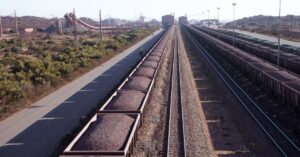
Rains are expected on the night of March 23 in Zakarpattia and Ivano-Frankivsk regions, and on Sunday afternoon in western, Zhytomyr and Vinnytsia regions, while the rest of Ukraine is expected to be without precipitation, the Ukrainian Weather Center reports.
Southeast wind, 7-12 m/s, gusts of 15-20 m/s during the day in Rivne, Khmelnytsky, Chernivtsi, Zhytomyr, Vinnytsia and Kyiv regions. Temperatures at night will be from 1° below zero to 4° above zero, in Transcarpathia and Prykarpattia 1-6° above zero; during the day 9-14° above zero, in the Carpathians 5-10° above zero.
No precipitation in Kyiv on March 23. Southeast wind, 7-12 m/s, gusts of 15-20 m/s during the day. The temperature will be 1-3°C at night and 11-13°C during the day.
According to the Borys Sreznevsky Central Geophysical Observatory. Borys Sreznevsky Central Geophysical Observatory, in Kyiv, for the entire period of observation on March 23, the highest daytime temperature was 20.4°C in 1913, the lowest nighttime temperature was -17.3°C in 1942.
On Monday, March 24, moderate, sometimes heavy rains are expected in the western and northern regions, light rains in most of the central, Odesa, and Mykolaiv regions, and no precipitation in the rest of the country.
Southeast wind, 7-12 m / s, during the day in Ukraine, except for most of the western and eastern regions, gusts of 15-20 m / s. The temperature will be 2-7° Celsius at night, 9-14° Celsius during the day, 11-16° Celsius in the southern and central regions.
It will rain in Kyiv on March 24. Southeast wind, 7-12 m/s, gusts of 15-20 m/s during the day. The temperature at night will be 4-6° Celsius, during the day 11-13° Celsius.

Mass protests continue in Turkey after the detention of Istanbul Mayor Ekrem Imamoglu, one of the main political opponents of President Recep Tayyip Erdogan; on Friday alone, 343 demonstrators were detained in nine cities, including Ankara and Istanbul, Radio Liberty reports, citing the Turkish Ministry of Interior.
Interior Minister Ali Erlikaya accused the demonstrators of trying to “disrupt public order and provoke chaos.” In addition to the protesters, 56 other people were detained separately for allegedly inciting unrest through social media.
Imamoglu was detained in the morning of March 19. He and about 100 other people were accused of corruption crimes and the creation of a criminal group that was engaged in extortion from businesses.
Imamoglu, whom the Republican People’s Party (CHP) is preparing to nominate as a presidential candidate, called the case politically motivated. On social media, he said the investigation was a “political coup” and called on citizens to fight back.
The Turkish Ministry of Justice claims that the case has no political basis.

In January-February of this year, Ukrainian mining companies reduced exports of iron ore in physical terms by 1.2% compared to the same period last year, to 5 million 595.706 thousand tons.
According to the statistics released by the State Customs Service on Tuesday, foreign exchange earnings from iron ore exports decreased by 18.7% to $449.388 million during this period.
Exports of iron ore were carried out mainly to China (46.50% of supplies in monetary terms), Poland (17.35%) and Slovakia (14.31%).
In January-February 2025, Ukraine imported iron ore worth $1 thousand in the amount of 5 tons from Italy.
As reported, in 2024, Ukraine increased its exports of iron ore by 89.8% compared to 2023 – up to 33 million 699.722 thousand tons, while foreign exchange earnings increased by 58.7% to UAH 2 billion 803.223 million.
In 2024, Ukraine imported iron ore for $414 thousand in a total volume of 2,042 thousand tons, while in 2023, 250 tons of this raw material were imported for $135 thousand.
In 2023, Ukraine decreased exports of iron ore in physical terms by 26% compared to 2022 – to 17 million 753.165 thousand tons, foreign exchange earnings from iron ore exports amounted to $1 billion 766.906 million
(down 39.3%). In 2023, Ukraine imported iron ore worth $135 thousand in a total volume of 250 tons.

Vyshnivskyi Foundry and Forging Plant (VLKZ, Kyiv region) reduced its net profit by 35.9% in 2024 compared to 2023, to UAH 2.987 million from UAH 4.663 million.
According to the annual report for 2024, the company’s net income decreased by 25.7% to UAH 68.327 million.
Retained earnings at the end of 2024 amounted to UAH 12.594 million.
According to VLCP’s announcement in the National Securities and Stock Market Commission’s (NSSMC) information disclosure system that it will hold a remote general meeting of shareholders on April 11, the shareholders will consider the report of the Supervisory Board for 2024 and make a decision based on the results of such consideration.
In addition, the shareholders will approve the results of financial and economic activities for the past year and determine the distribution of profits. It is planned to decide on the payment and approval of the amount of annual dividends and the method of their payment.
The draft resolutions, a copy of which is available to Interfax-Ukraine, propose to distribute the company’s net profit for 2024 in the amount of UAH 2 million 986 thousand 873.04 as follows 75%, which amounts to UAH 2 million 240 thousand 285.41, to be used to pay dividends; 25%, which amounts to UAH 746 thousand 587.63, to be left undistributed. To pay dividends for 2024 directly to shareholders in the amount of UAH 1.563 per share.
In addition, the shareholders will approve a new version of the charter, amend the company’s bylaws and give prior consent to enter into significant transactions.
As reported, VLCP increased its net profit by 2.1 times compared to the previous year to UAH 7.099 million in 2022. Retained earnings by the end of 2022 amounted to UAH 13.077 million.
VLKZ was founded in 1990 on the basis of the foundry and forging shops of the Artem Kyiv Production Association. It specializes in the production of forging and casting products.
According to the third quarter of 2024, the company’s shares are owned by a resident individual, Victoria Gryshchenko, who holds 18.5947% of the company’s shares, while Aviation and Rocketry Engineering Company JSC owns 51.0001%.
The authorized capital is UAH 358 thousand, the nominal value is UAH 0.25.

On April 26, 2025, Uzhhorod will host the largest medical event in Ukraine – the Breast Weekend 2.0 conference, which will bring together industry leaders to share experiences, discuss modern techniques and the latest approaches in the field of aesthetic and oncoplastic mammoplasty. The conference is organized by Lita Plus Plastic Surgery Clinic.
The event will bring together more than 200 leading plastic surgeons, oncologists, cosmetologists, dermatologists and reconstructive surgeons to discuss topical issues of mammoplasty and at the same time support the Armed Forces of Ukraine.
The main mission is medicine for victory
In addition to its scientific value, the conference has a key charitable goal: all funds raised will be used to support the Armed Forces of Ukraine.
During the gala dinner that will take place after the conference, an additional fundraiser will be held to help the Ukrainian military.
About theorganizer: Lita Plus Clinic is a center for plastic surgery and aesthetic medicine that has already organized three charity conferences since the beginning of the full-scale invasion and purchased more than 10 vehicles for the military with the proceeds from previous events.

Program and key topics of the conference:
Speakers:
Sergiy Derbak , founder and head of Lita Plus clinic; Ruslan Humennyi , founder and plastic surgeon of PlastArt clinics; Vasyl Khrapach , MD, , professor of the Department of Surgery at Bogomolets National Medical University; Yevhen Simulik , head of the Department of Microvascular, Plastic and Reconstructive Surgery at the National Center of Surgery and Transplantation named after O.O. Shalimov; Sergiy Romanyuk, Head of the Surgical Department of the Artmedium Clinic, Doctor of the highest category; Denys Pominchuk , Founder of the VERUM EXPERT Clinic; Andriy Zhyhulin , Head and Founder of the Mammology Center at the LISOD Israeli Oncology Hospital; Bohdan Shevnya , Director of Altamedica Medical Center LLC; Oleg Savenkov , Head of the Department of Plastic and Reconstructive Surgery at the Garvis Clinic; Artem Fedosov , Head of the Mammology Center at the Innovation Clinic; Oleksandr Karpinsky, surgeon at the Lita Plus Clinic; Ihor Drobner, oncologist and mammologist at the Khmelnytsky Regional Anti-Tumor Center; Tetiana Shevchuk, oncologist and mammologist at the VERUM EXPERT Medical Center; Sergiy Chuklin, oncologist and mammologist at St. Paraskeva Medical Center; Dmytro Bukhteev, oncologist and mammologist at the Center for Mammology at LISOD Israeli Oncology Hospital; Dmytro Mozhayev, oncologist, plastic surgeon at the Harvis Clinic and Medical Plaza, etc.
Conference partners: Motiva, Polytech Ukraine, Mentor Optimum Ukraine, Mentor Askmed, Vaser, CareForm.
Media partners: General media partner – Interfax Ukraine news agency; TV partner – Pryamyy TV channel.
With the support of associations – UPRADAS, ESSA.
Date: April 26, 2025
Venue: Uzhhorod, hotel complex “Derenivska Kupil”
Start time: 08:00.
Online registration, agenda and other information are available on the website: https://livesurgery-transcarpathian.com
Media accreditation: +38 095 123 28 83, pr@litaplus.com (contact person: Kira Skrypnyk).
Interfax-Ukraine is the general media partner of the Forum.

The European Commission (EC) wants to have a well-balanced list of goods from the United States on which it intends to impose higher tariffs and buy time for trade talks with Washington, so it is postponing the deadline for its countermeasures.
EC spokesmen explained at a briefing in Brussels on Friday that there are two complementary parts of the list of goods. One is due to enter into force on April 1, and the other in mid-April.
“This week, the (European) Commission decided to reconcile the schedule of its various countermeasures. This is because, by clarifying this schedule, it is possible to consult with member states on both lists. Secondly, it allows us to be more effective, to achieve a better balance between products, taking into account the interests of European producers, exporters, consumers,” said Olof Gill, the EC spokesman.
“And this allows us to have more time to discuss with the US administration. Let me remind you that our goal is to avoid customs duties that would harm everyone on both sides of the Atlantic. That’s why we are preparing for negotiations with the United States, trying to buy time to reach an agreement,” added Gill.
According to him, if these talks do not lead to a satisfactory result, there will be a “firm and targeted reaction” of the EU in response to the US measures in order to “reduce the negative consequences for Europe”.
“We will be ready to respond to any development,” the EC representative emphasized.
Earlier, EC President Ursula von der Leyen said that the postponement of the application of increased EU customs duties to a number of American goods is related to the search for the best consideration of the interests of the European side. “We have decided to clarify the time when our tariffs will take effect. This does not change the effect of our retaliatory measures. And this is important, because they reach 26 billion euros, which is the equivalent of $28 billion of potential US tariffs,” the EC President said at a press conference in Brussels on Friday night.